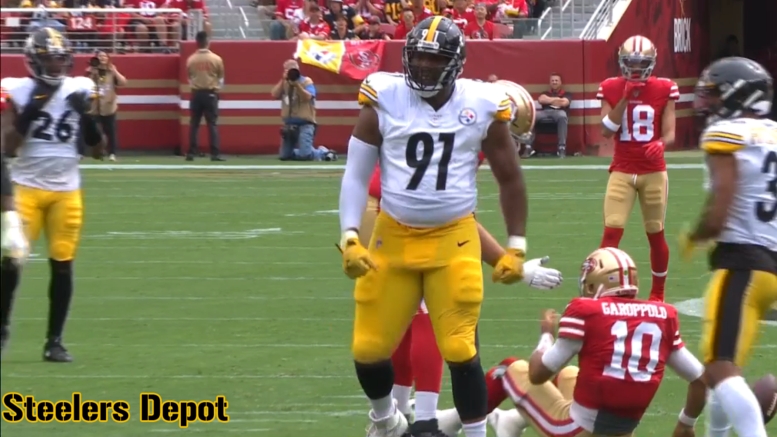There have been recent comments on these pages expecting that Pittsburgh will target rookies who can contribute ‘early and often.’ I hope people aren’t serious about that. The Steelers pick at #49 overall, followed by #102. Other than a running back and in the absence of a serious injury, no available player is going to earn more than seasoning and/or special teams snaps. This is the norm; what people should therefore expect; and as a sports fan it is the way I think things ought to be.
“Could” it happen? Sure. There are always the proverbial exceptions who prove the rule, like JuJu Smith-Schuster a few years back. But “coulds” are things to fantasize about, not to anticipate. Using the word “expect” would be unfair to the team, the individual players, our fellow fans, and our own piece of mind.
Poster capehouse and I recently went through a pretty thorough examination of this in the comments to Tom Mead’s mock draft. Capehouse did a lot of good research that I have since confirmed through Pro Football Reference. He came to the discussion arguing that the team used rookies more often and with better results in recent years than used to be the case. The research ended up showing the opposite – there is indeed a recent trend of higher rookie snaps, but in all cases they happened due to a significant injury to the starter, or an actual hole on the roster; and no rookie but Smith-Schuster and Le’Veon Bell (the RB exception) contributed high quality snaps.
Not that I turned out to be totally right either. The record showed that injuries happen a lot more often than I had remembered, and rookies really have been forced onto the field more than one might wish. As in most good discussions we were both forced toward the middle.
The conversation revealed one other obvious point that I’m sure we both feel a little silly for failing to mention. Rookies get fewer snaps on strong teams than they do on weak ones. [Duh]. That leaves very little room for 2020 rookies because the Steelers have no particular weaknesses in the starting lineup. The roster gaps only start to appear when you dig down to the depth positions, or talk about long term upgrades from good to better.
Yes, we fans have reason to worry about positions like RB2 behind the oft-injured Conner, TE2 behind the almost-as-often-injured Vance McDonald, WR4, DT4, SAF3, etc. Worrying is the flip side of dreaming, which is why Steeler Nation will never be satisfied with anything less than perfection. But we also need to realize that depth concerns are way, way less important than the sort of holes that 90% of the league is trying to solve.
But let’s get to the data. There have been 13 drafts since Mike Tomlin took over as the head coach. The first four years he had a Super Bowl caliber roster, and ended up with the following selections. None of these four saw any significant snaps in his rookie year:
- 2007 = Lamarr Woodley. Saw occasional spot duty behind Clark Haggans. Looked very good in his very few snaps, so much so that he was expected to become the starter in his second year and first rounder Lawrence Timmons became the target of fan hatred.
- 2008 = Limas Sweed. Could not crack the lineup until Dallas Baker got hurt in week 7, and then went on to the lack-of-career we all remember.
- 2009 = Kraig Urbik. No snaps, lost the position to Ramon Foster in the offseason, and was quickly traded away.
- 2010 = Jason Worilds. Played in only one game. No snap counts available. Looked basically ‘meh’, but flashed enough for the fan hatred to fall on Emmanuel Sanders more than it did on him, if only by a little.
Why the lack of snaps? Simple. There were no holes on a very good roster, and no significant injuries to create those holes. Years 4-8 saw second round rookies who did earn significant snaps. In three cases it was due to injuries. The fourth was a running back. [NOTE: Bud Dupree played 980 snaps last year for a rate of 90%, which was more than any other player].
- 2011 = Marcus Gilbert. Started 13 games after Willie Colon got injured. It should be noted that Gilbert played poorly during his rookie season (compared to a vet), which created several years of unjustified nastiness aimed in his direction from the fanbase.
- 2012 = Mike Adams. 488 snaps, all logged after Marcus Gilbert was injured. He did not play well either, and a running joke started to the effect that only Mike Adams could have made Steeler Nation “forgive” Marcus Gilbert.
- 2013 = Le’Veon Bell. 677 snaps. We all know the stereotype: RB’s produce sooner and last less long. Bell helped to create that stereotype. But he also improved a lot going into Year 2. Remember how Bell lost 10-20 pounds and added quickness? He contributed valuable snaps as a rookie, but did not arrive until Year 2.
- 2014 = Stephon Tuitt. 370 snaps, almost all in the final four games after Brett Keisel got hurt. Tuitt had basically no snaps before that point.
Tuitt deserves a bit of deeper study because he (a) was a supreme talent, and (b) gave interviews that help to explain why rookies need to sit. Steelers Nation reveres Brett Keisel – and I think he deserves it – but people tend to forget that he was a much better Steeler than starter. Keisel spent most of his career as a backup to Kimo von Olhoffen, Casey Hampton, and Aaron Smith. He only earned a starting role in his final few years when the stars in front of him began to retire. Going into 2014 he’d also started to look long in the tooth.
For those who forget, Stephon Tuitt was widely considered a Round 1 target for a Pittsburgh team that needed to ease Da Beard on out. The Notre Dame Junior had flashed amazing positives in college along with a lot of lackluster film, was only 20 years old, and many of his issues could be explained by a nagging hernia problem that required additional offseason surgery. He only fell because Ryan Shazier proved to be even more appealing in Round 1. Thus 2014 presented the classic situation of a savvy but aging journeyman who would “obviously” get beaten out by the supremely talented young rookie. It didn’t happen.
Why not? Because rookies come into the league as overgrown college kids who need to learn the game before they can compete with grown men.
Tuitt himself made no bones about that. During 2015 OTA’s (going into his Year 2) he said in an interview: “Brett Keisel taught me a lot in one year. I can’t imagine if he was here one more year, how much [more] I would have learned. I got the confidence now to do the stuff I learned from him being a great mentor.” Those same words get spoken every year by every young star on the verge of making his Sophomore Leap – a phrase I can capitalize because the process is so very common that it’s become a proper noun.
2020 offers a very strong draft class, and I have no doubt the Steelers will get a very fine prospect in Round 2. But he won’t be a better prospect than Tuitt was in 2014. There are no better Round 2 prospects than Stephon Tuitt. The most we can hope for is a Tuitt peer at some other position, which means that youngster will be unable to beat out the vet in front of him until the earlier of Year 2 or an unfortunate injury. RB’s excepted.
The next year’s second round pick got no snaps:
- 2015 = Senquez Golsen.
But then, in the most recent years, we see four players in a row who did play fairly often:
- 2016 = Sean Davis. 740 snaps.
- 2017 = JuJu Smith-Schuster. 704 snaps.
- 2018 = James Washington. 526 snaps.
- 2019 = Diontae Johnson (pick 3:02 but it is fair to include him). 652 snaps.
That is a lot of snaps! For four years in a row! Doesn’t this disprove my premise? In a word: no. In every case the rookie played only because of existing roster holes and injuries.
Sean Davis was drafted in 2016 after the Steelers’ historic depth at the position dissolved away. Ryan Clark and Troy Polamalu had departed in 2014, followed by Will Allen in 2015. The team brought in a pricey free agent in 2014 to fill some of that yawning chasm (Mike Mitchell), but going into 2015 had Robert Golden inked in as the starting Strong Safety with no depth at all. It did not help that the CB position was even weaker! The secondary was a disaster… In any case, the team picked boom-or-bust Corner Artie Burns late in Round 1 of the 2016 draft, and then followed up in Round 2 with a high-floor prospect in Safety Sean Davis. Those who were around at the time will remember the fanfare when Mike Tomlin enthused about Davis’ high football IQ, coverage skills in college, and also his exceptional (for a rookie) conditioning. The fanbase expected Davis to be a Day 1 starter. It did not happen. Golden started the first nine games despite an unending din of complaints from Steeler Nation; the pair shared snaps for games 10-11; and then Davis took over for games 12-16. Davis’ play… well, let’s just say that fans weren’t happy. At least he was protected a bit by the knowledge that removing him would only result in going back to what we’d had before. Golden actually out-performed Davis in most ways, but at least we could argue that the extra work as a rookie would all but guarantee 2017 success. If we’d only known.
Juju quickly earned renown in 2017 as the exception to the rule. He played a lot, and he played well. But it should be remembered that this did not happen in a vacuum. The starting pair two seasons before, in 2015, had been AB and Martavis Bryant. The starting pair in 2016 was AB and Sammie Coates; Bryant having been suspended. The JJSS pick surprised all us draftniks because we expected great things from the AB/Bryant/Coates trio in 2017. But behind the scenes lay trouble that we knew nothing about! Coates’ had basically shattered his fingers and would never recover, while Bryant’s mental health was getting ever more suspect. AB appeared to be the only stable one (an irony if ever there was one). In any case, Bryant started the 2017 season in full malcontent mode and it only got worse. Tomlin finally benched him for a game, and then the team traded him away as soon as the season ended. So, in a way, even Juju Smith-Schuster’s snap count was inflated by an unexpected “injury.”
James Washington came into the 2018 gap left by Bryant’s departure, and was one of Pittsburgh’s highest-floor prospects in recent memory. Between Juju’s rookie success and all that wonderful film, we expected great things of James Washington in his rookie year. Even moreso with no one but Darrius Heyward-Bey and Eli Rogers there to compete for the WR3 position. Reality disappointed. JW quickly reminded us that greatness in college does not directly translate to even acceptable skill levels for the NFL. The young receiver saw the field a lot, but gathered in only 16 receptions and proved to be little more than a distraction for the primary targets: Antonio Brown, Juju Smith-Schuster, TE Vance McDonald, and RB James Conner. Free agent Ryan Switzer outshone the rookie by a wide margin. [NOTE: Washington made a very significant Sophomore Leap and we expect nothing but even more success when Roethlisberger returns].
Diontae Johnson came in last year, and we all know the story. Antonio Brown went nuts in the offseason. The Steelers brought in a free agent star (Donte Moncrief) to be the WR2 behind Juju. Washington and Switzer were the presumptive WR3 and WR4 candidates, with TE Vance McDonald and RB James Conner as the presumptive outlets for everything else. That would give Johnson plenty of time to mature as the chosen protege of beloved WR coach Darryl Drake. And then the disasters piled up, leaving Washington and Johnson as the only men standing.
All of that history should make it clear. No rookie selected at pick #49 (let alone #102) will have any real chance of seeing the field early, often, or with any success unless that rookie is a running back and/or gets forced on to the field by some serious injury to the anticipated starter. We can hope all we want but that is the reality we need to expect.
Conclusion
Some people may see that last paragraph as a downer. I do not. Emphatically. The Steelers win so consistently precisely because they take a long term view of the draft, using it to build for the future rather than in almost-always-vain hopes of plugging an existing hole. Wishing for that to change amounts to wishing away the Steelers’ greatest assets: stability, wisdom, far-sightedness, and the long term benefits of class and character at the top.
I also, perhaps selfishly, prefer the image of football as a game manned by men who have to learn their craft with years of hard work and study. What would it say if success came from pure, youthful talent that could not be improved after the age of 22? That football had turned into women’s gymnastics? No thank you. I will take the game that requires men over boys.
The Steelers will be better in 2021, but it won’t be because of the rookies. The improvement will come – as it should! – from the free agents (FB Derek Watt, TE Erik Ebron, DL Chris Wormley), and especially from the 2018 and 2019 drafts: James Washington, Chuks Okorafor, Mason Rudolph, and Marcus Allen (2018), plus Devin Bush, Justin Layne, Benny Snell Jr., Zach Gentry, Isaiah Bugs, Ulysses Gilbert III, and maybe even Derwin Gray or a UDFA (2019). We are already “all in” for the Super Bowl runs during Big Ben’s final years. That ship has sailed. Now is the time to keep replenishing the pipeline, or to grab a top RB for immediate use and then replenish with all the other picks.








